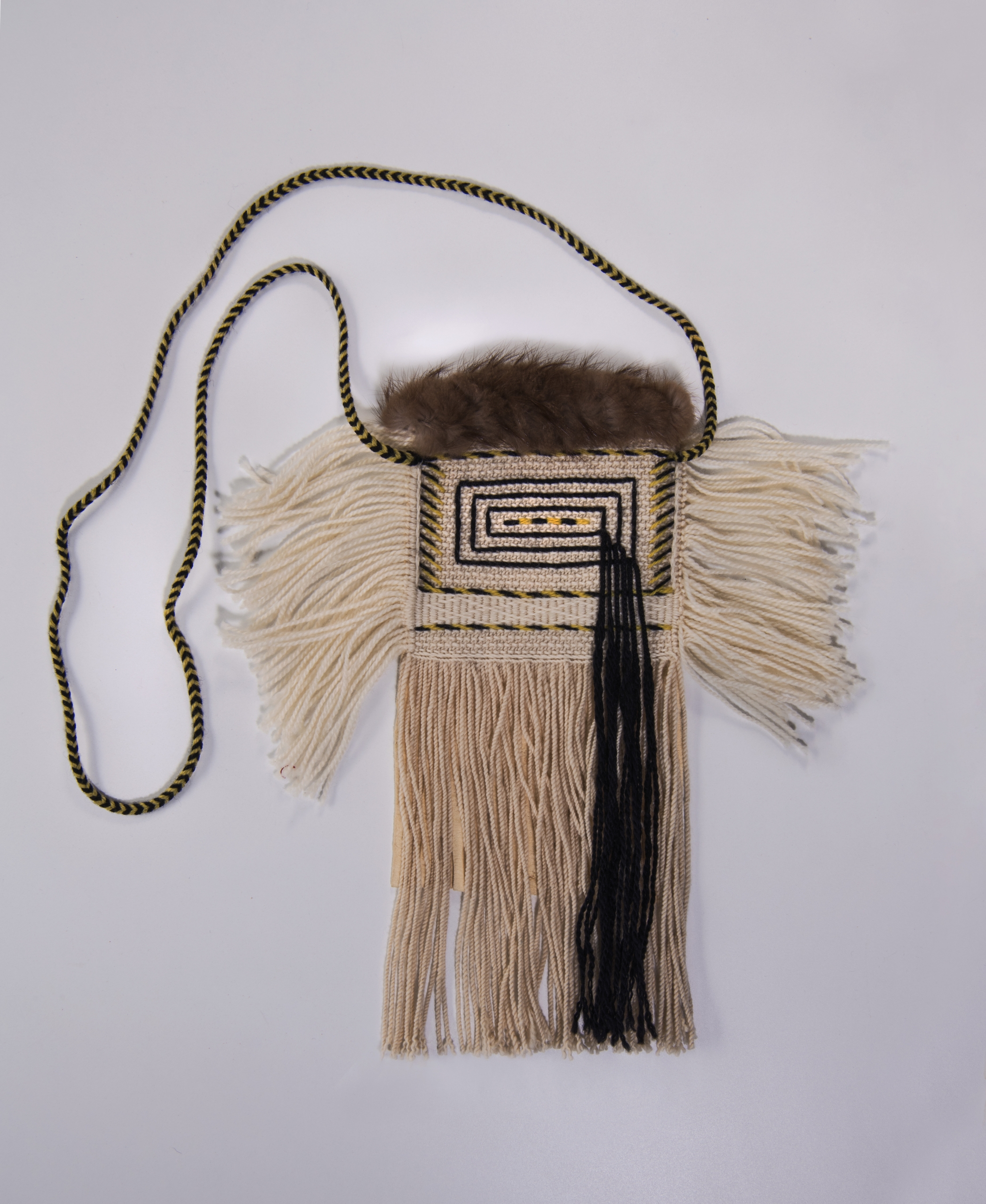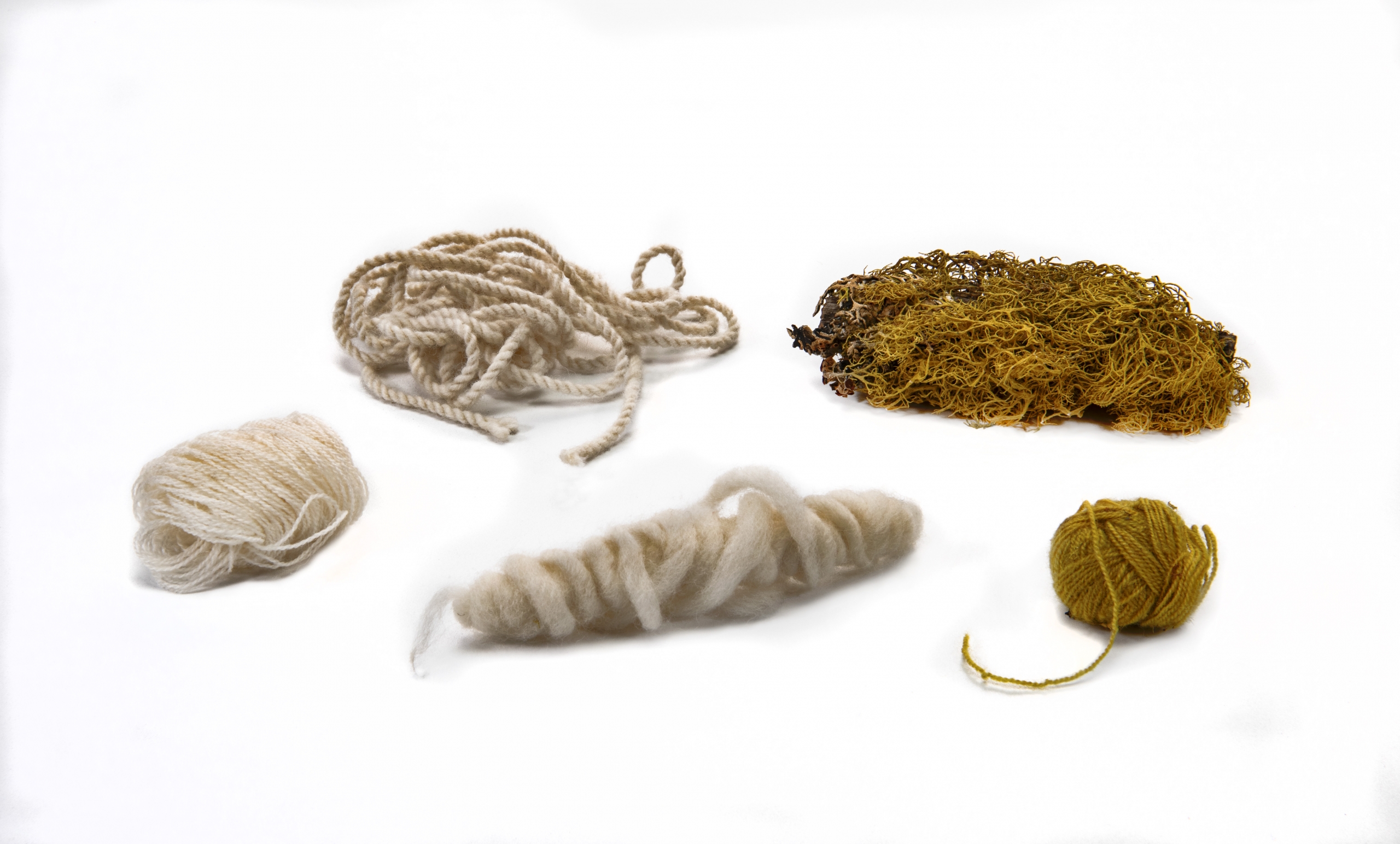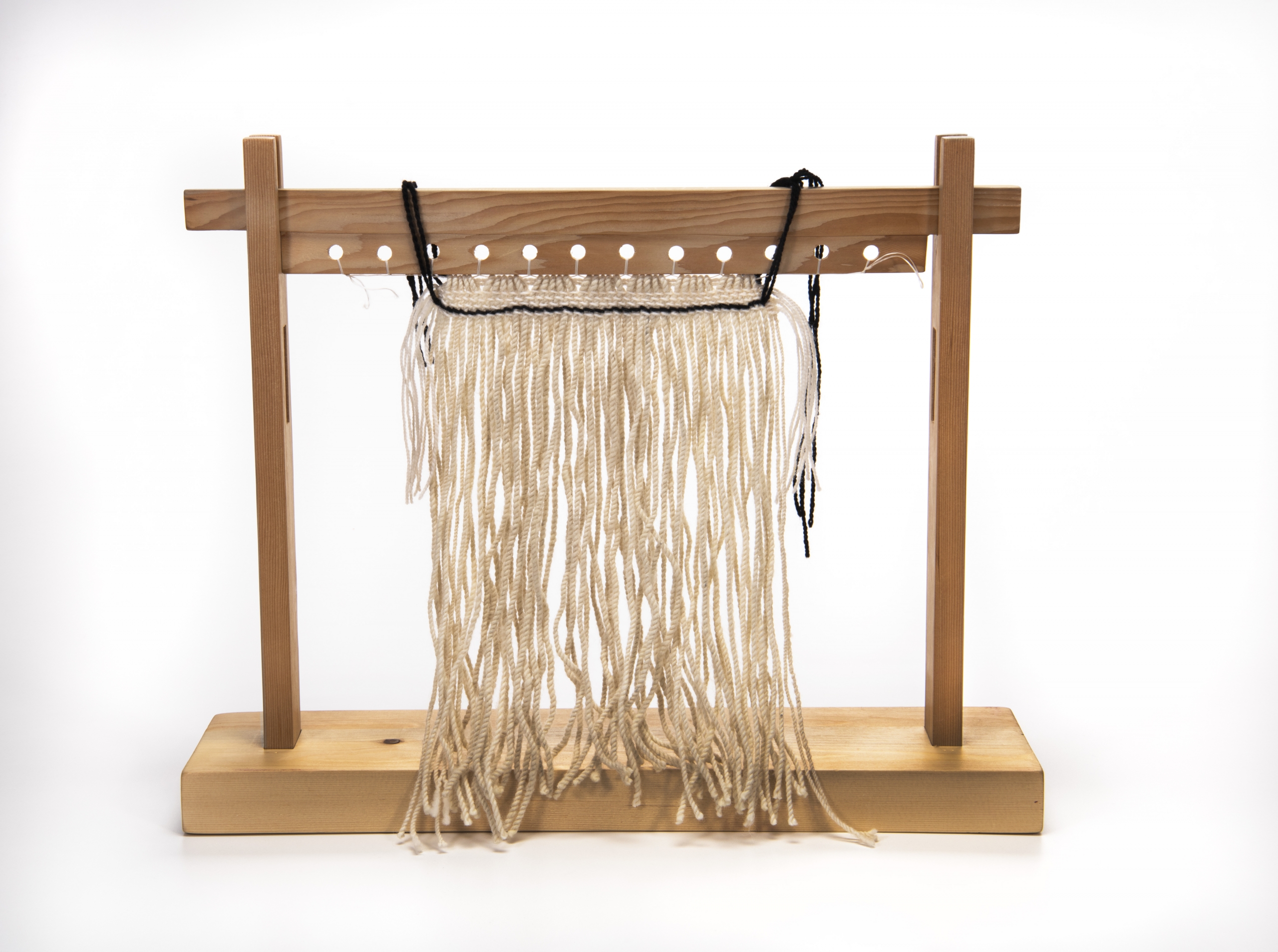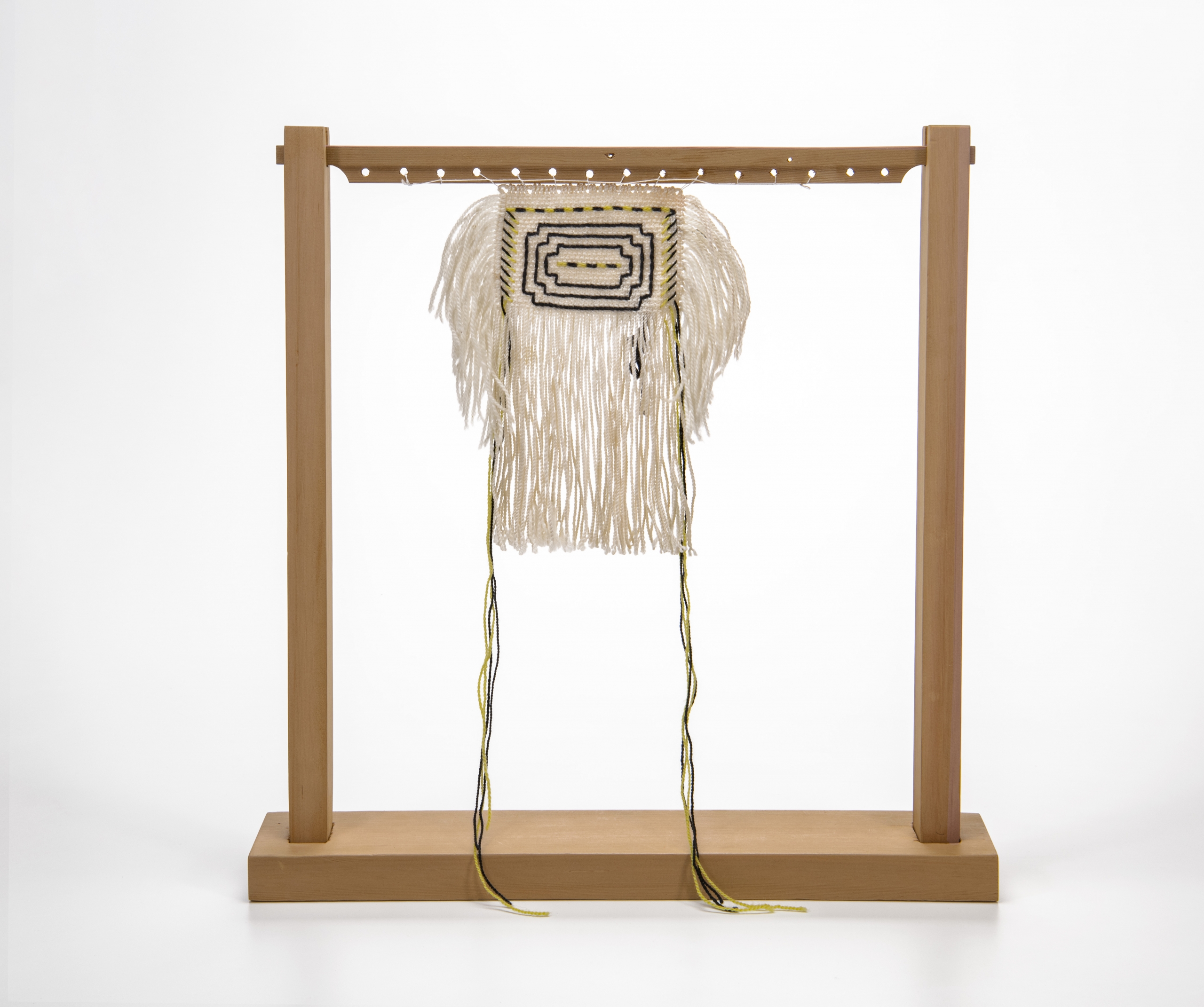Raven’s Tail Weaving in Progress
Artifact
Image
Video
Audio
 Activities
Activities
LOOK
Look at the X̱uuya k’iida (Raven’s Tail) weaving at different stages in its creation. How would you explain the steps in the weaving process, using your own words?
LOOK
Look at the X̱uuya k’iida (Raven’s Tail) ceremonial robe, created in 2011. What similarities and differences do you see between it and the final product seen in these images?
Details
 Materials
Materials - Wood
- Wool
Historical Context
Choose one of the three levels below to match your needs.
- Here we see the steps in the Raven’s Tail weaving process:
- Dye the wool, using natural dyes, and spin it into yarn.
- Set up the loom. Tie the heading cord to the bar loom; then tie the warps (vertical threads) to it. Weave the wefts (horizontal threads) around the warps, from left to right.
- Add fringes and furs to finish the piece.
- The finished piece has a “box within a box” pattern.
X̱aaydaa (Haida) artist Kujuul Evelyn Vanderhoop made this Raven’s Tail weaving in stages. The “box within a box” pattern on the finished piece represents t’áwt (bentwood boxes) that are used to house precious belongings, both natural and supernatural.
Traditionally, weaving has been the role of the jáadaa (women). Techniques are still passed down from mother to daughter. These are the basic steps:
- Source the wool (traditionally from a máat (mountain goat)).
- Dye the wool, using natural dyes, and spin it into yarn.
- Set up the loom. Tie the heading cord to the bar loom; then tie the warps (vertical threads) to it. Weave the wefts (horizontal threads) around the warps, from left to right.
- Add fringes and furs to finish the piece.
X̱aaydaa (Haida) artist Kujuul Evelyn Vanderhoop made this Raven’s Tail weaving in stages for the Canadian Museum of History. The finished piece shows a “box within a box” pattern. The concentric rectangles represent t’áwt (bentwood boxes) that are used to house precious belongings. According to stories passed down through the generations, such boxes can keep natural and supernatural treasures safe.
Traditionally, weaving has been the role of the jáadaa (women). Techniques are still passed down from mother to daughter. First, wool (traditionally from a máat (mountain goat) must be acquired, dyed and spun. Plant dyes such as wolf moss and hemlock bark were often used. This is why we see yellow, black and white in Raven’s Tail works.
Second, the weaver ties the heading cord to the bar loom. The warps (vertical threads) are then tied to this heading cord, and the wefts are woven around the warps. In Raven’s Tail weaving, all rows start at the left and end with a tie-off fringe on the right. The geometric patterns emerge as more material is added, row by row.
Lastly, to finish the piece, the weaver can add more fringe and furs. Ḵúu (sea otter) fur was used historically, but since otters are endangered, beaver fur is more common.
- Here we see the steps in the Raven’s Tail weaving process:
- Dye the wool, using natural dyes, and spin it into yarn.
- Set up the loom. Tie the heading cord to the bar loom; then tie the warps (vertical threads) to it. Weave the wefts (horizontal threads) around the warps, from left to right.
- Add fringes and furs to finish the piece.
- The finished piece has a “box within a box” pattern.
X̱aaydaa (Haida) artist Kujuul Evelyn Vanderhoop made this Raven’s Tail weaving in stages. The “box within a box” pattern on the finished piece represents t’áwt (bentwood boxes) that are used to house precious belongings, both natural and supernatural.
Traditionally, weaving has been the role of the jáadaa (women). Techniques are still passed down from mother to daughter. These are the basic steps:
- Source the wool (traditionally from a máat (mountain goat)).
- Dye the wool, using natural dyes, and spin it into yarn.
- Set up the loom. Tie the heading cord to the bar loom; then tie the warps (vertical threads) to it. Weave the wefts (horizontal threads) around the warps, from left to right.
- Add fringes and furs to finish the piece.
X̱aaydaa (Haida) artist Kujuul Evelyn Vanderhoop made this Raven’s Tail weaving in stages for the Canadian Museum of History. The finished piece shows a “box within a box” pattern. The concentric rectangles represent t’áwt (bentwood boxes) that are used to house precious belongings. According to stories passed down through the generations, such boxes can keep natural and supernatural treasures safe.
Traditionally, weaving has been the role of the jáadaa (women). Techniques are still passed down from mother to daughter. First, wool (traditionally from a máat (mountain goat) must be acquired, dyed and spun. Plant dyes such as wolf moss and hemlock bark were often used. This is why we see yellow, black and white in Raven’s Tail works.
Second, the weaver ties the heading cord to the bar loom. The warps (vertical threads) are then tied to this heading cord, and the wefts are woven around the warps. In Raven’s Tail weaving, all rows start at the left and end with a tie-off fringe on the right. The geometric patterns emerge as more material is added, row by row.
Lastly, to finish the piece, the weaver can add more fringe and furs. Ḵúu (sea otter) fur was used historically, but since otters are endangered, beaver fur is more common.
Summary
- Here we see the steps in the Raven’s Tail weaving process:
- Dye the wool, using natural dyes, and spin it into yarn.
- Set up the loom. Tie the heading cord to the bar loom; then tie the warps (vertical threads) to it. Weave the wefts (horizontal threads) around the warps, from left to right.
- Add fringes and furs to finish the piece.
- The finished piece has a “box within a box” pattern.
Essential
X̱aaydaa (Haida) artist Kujuul Evelyn Vanderhoop made this Raven’s Tail weaving in stages. The “box within a box” pattern on the finished piece represents t’áwt (bentwood boxes) that are used to house precious belongings, both natural and supernatural.
Traditionally, weaving has been the role of the jáadaa (women). Techniques are still passed down from mother to daughter. These are the basic steps:
- Source the wool (traditionally from a máat (mountain goat)).
- Dye the wool, using natural dyes, and spin it into yarn.
- Set up the loom. Tie the heading cord to the bar loom; then tie the warps (vertical threads) to it. Weave the wefts (horizontal threads) around the warps, from left to right.
- Add fringes and furs to finish the piece.
In-Depth
X̱aaydaa (Haida) artist Kujuul Evelyn Vanderhoop made this Raven’s Tail weaving in stages for the Canadian Museum of History. The finished piece shows a “box within a box” pattern. The concentric rectangles represent t’áwt (bentwood boxes) that are used to house precious belongings. According to stories passed down through the generations, such boxes can keep natural and supernatural treasures safe.
Traditionally, weaving has been the role of the jáadaa (women). Techniques are still passed down from mother to daughter. First, wool (traditionally from a máat (mountain goat) must be acquired, dyed and spun. Plant dyes such as wolf moss and hemlock bark were often used. This is why we see yellow, black and white in Raven’s Tail works.
Second, the weaver ties the heading cord to the bar loom. The warps (vertical threads) are then tied to this heading cord, and the wefts are woven around the warps. In Raven’s Tail weaving, all rows start at the left and end with a tie-off fringe on the right. The geometric patterns emerge as more material is added, row by row.
Lastly, to finish the piece, the weaver can add more fringe and furs. Ḵúu (sea otter) fur was used historically, but since otters are endangered, beaver fur is more common.




